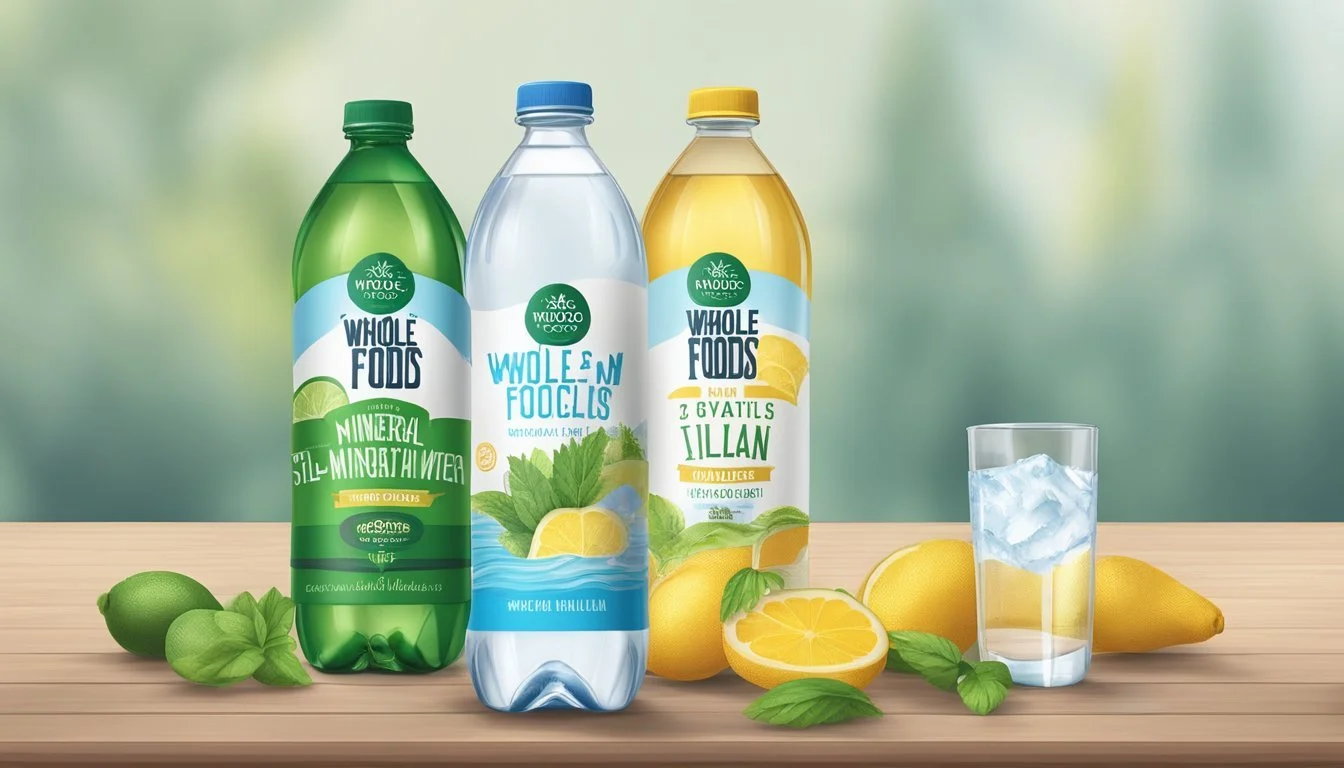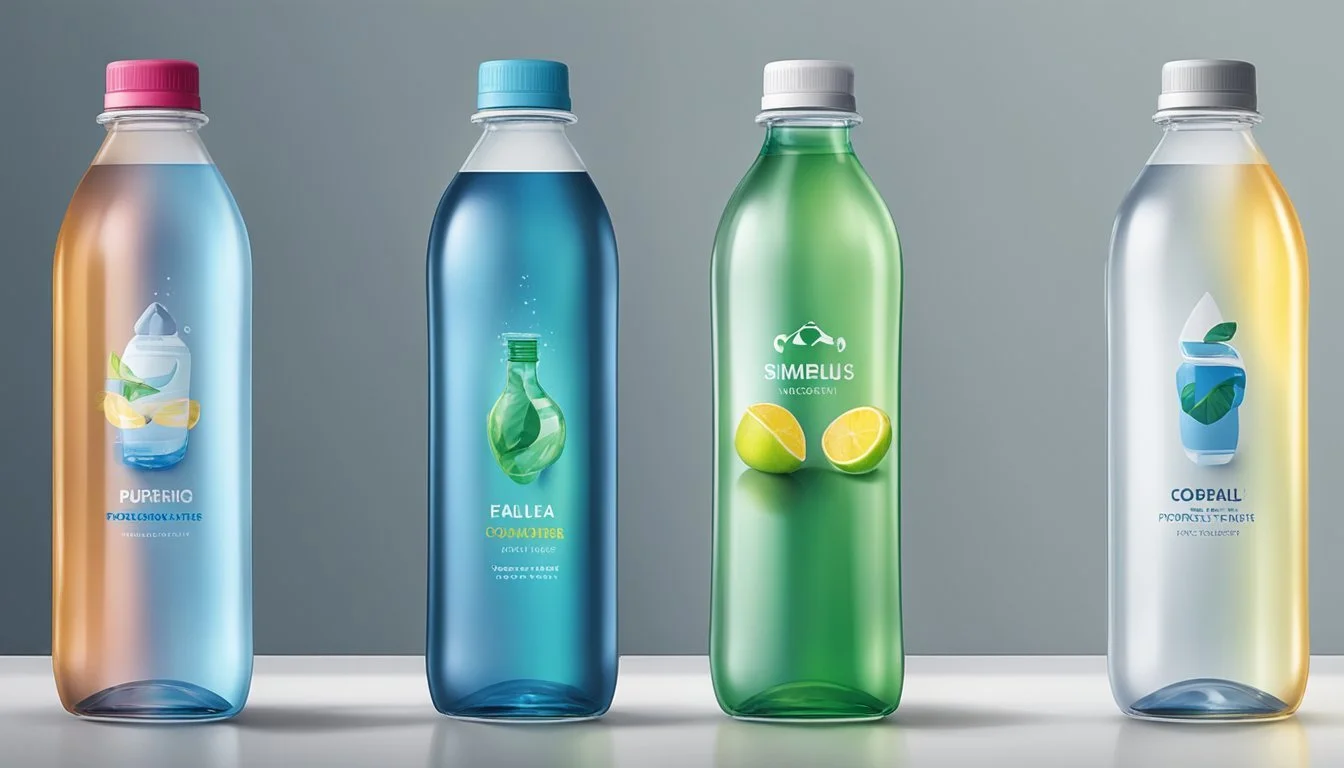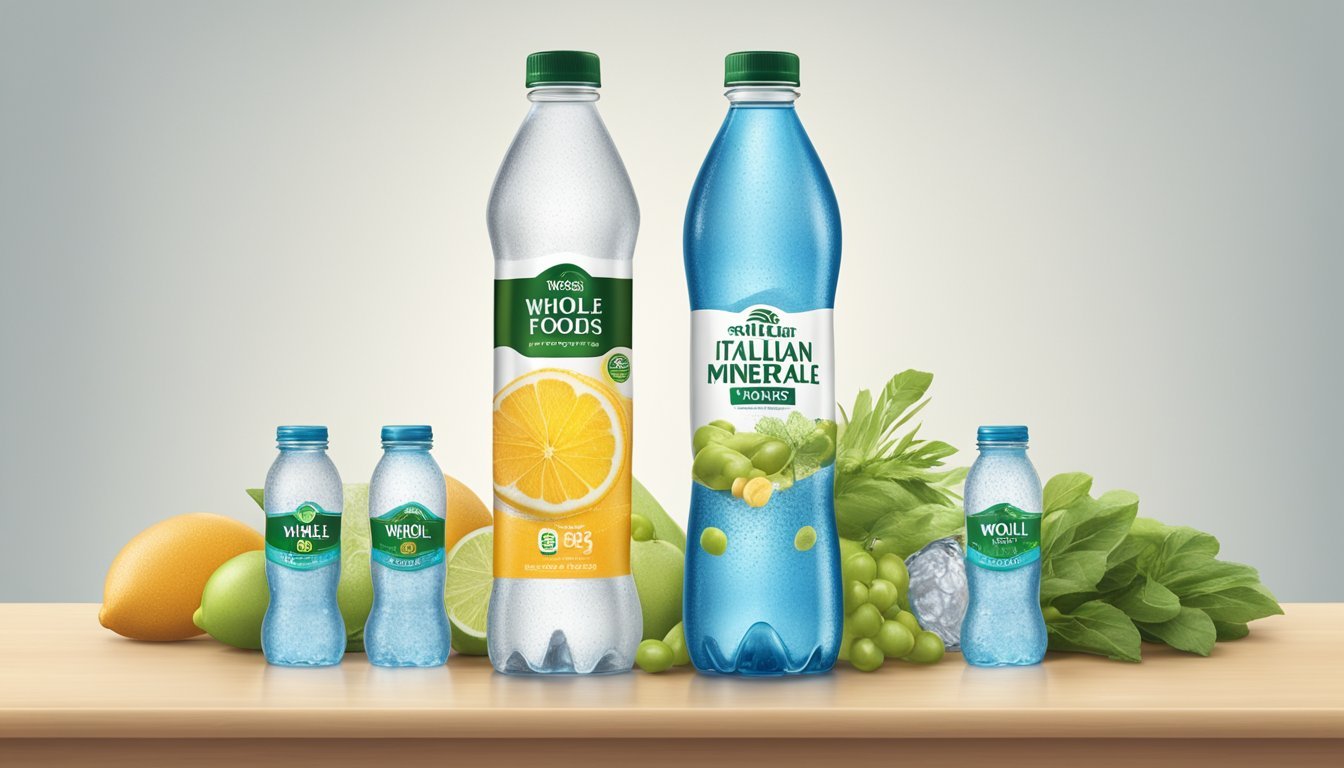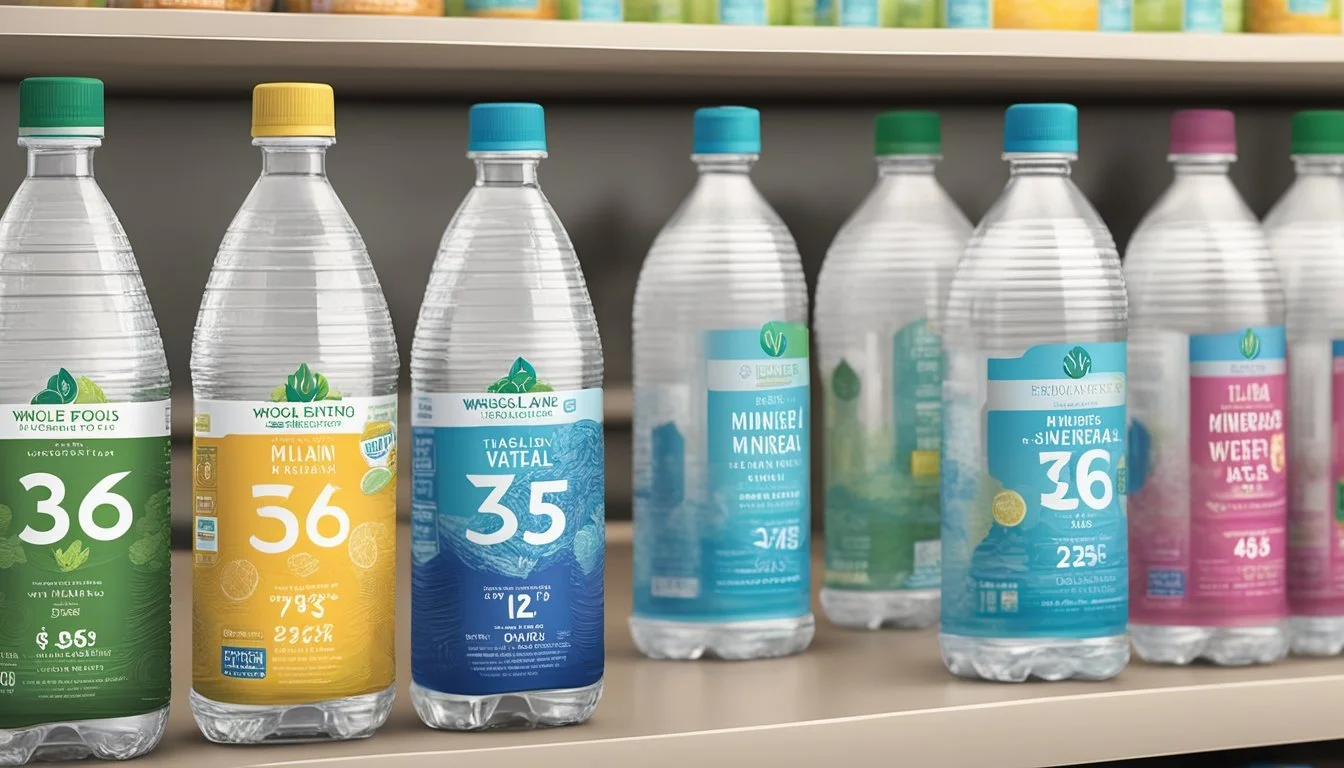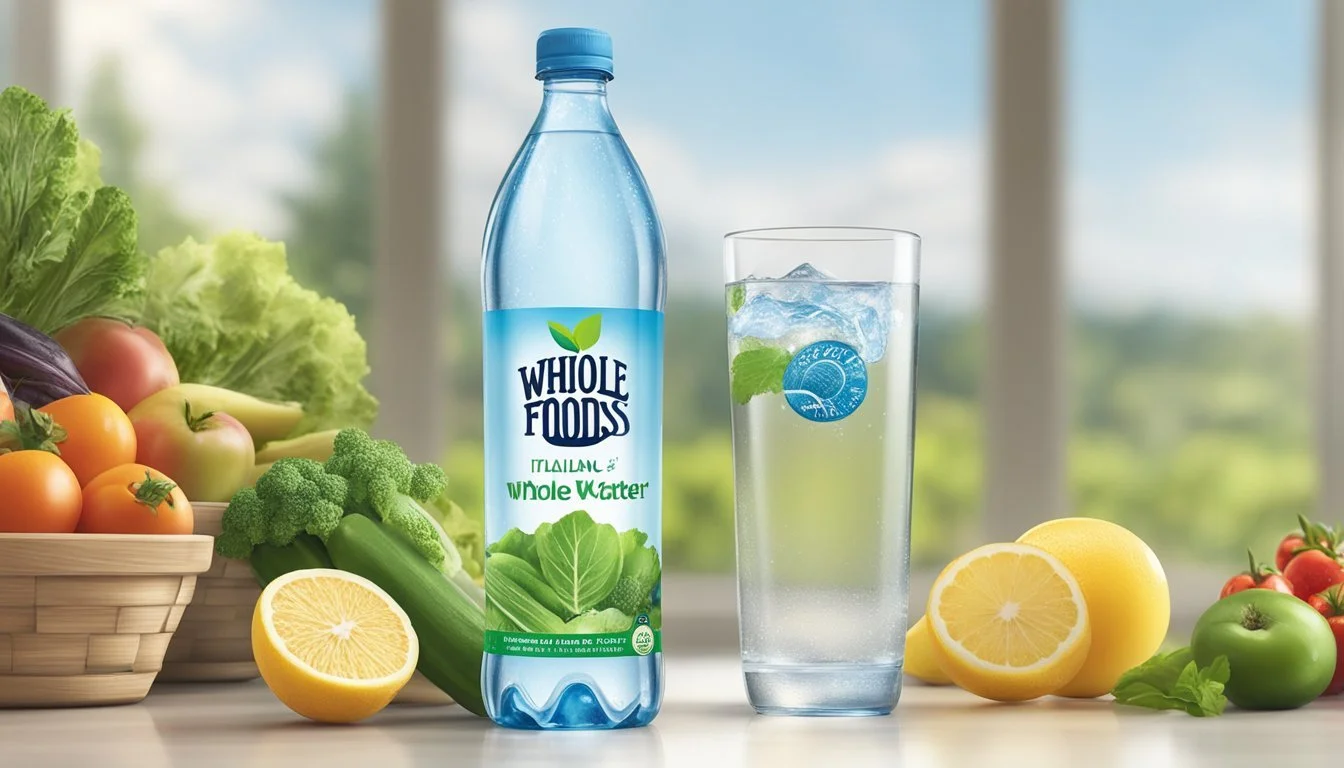Whole Foods Italian Still Mineral Water vs. Whole Foods 365
Expert Comparison
When it comes to bottled water, discerning between different brands can make a significant impact on your hydration experience. Whole Foods offers two prominent choices: Whole Foods Italian Still Mineral Water and Whole Foods 365. Each of these bottled waters brings unique elements to the table, catering to varied tastes and preferences.
While Whole Foods Italian Still Mineral Water is praised for its clean, pleasant flavor, thanks to meticulous distillation and filtration processes, Whole Foods 365 provides an economically friendly option without compromising on basic quality. Consumers looking for a high-end, flavorful hydration experience may prefer the Italian Still Mineral Water, whereas those seeking cost-effective daily hydration might opt for Whole Foods 365.
Understanding the advantages and characteristics of each product helps in making an informed choice that aligns with individual needs and preferences. Whether one prioritizes premium quality or affordability, this comparison aims to clarify which Whole Foods bottled water could be the better fit for diverse hydration goals.
Understanding Bottled Water
Bottled water comes in various types, each with unique characteristics and benefits. This section explores the definition and historical context, as well as the different types of bottled water available.
Definition and Overview
Bottled water refers to water sealed in bottles for consumption. These bottles can be plastic or glass and vary in size from small single-serving bottles to large gallon-sized containers. Bottled water can come from different sources, such as springs, wells, or public water systems.
Mineral water contains natural minerals and elements beneficial for health. Spring water, sourced from natural springs, retains its mineral properties. Some bottled waters undergo carbonation, becoming sparkling water. Tap water can also be bottled after treatment and purification.
Historical Context
The practice of bottling water dates back to ancient civilizations. The Romans, for example, were known to bottle water in glass containers. However, commercial bottling of water began in the 17th century, with the first documented instance in the United Kingdom.
By the 19th century, bottled mineral water became popular for its perceived health benefits. Advances in bottling technology in the 20th century led to mass production. Today, bottled water is a global industry, with a wide range of brands and types available to consumers.
Types of Bottled Water
Mineral Water: Contains naturally occurring minerals like calcium and magnesium. Sourced from mineral springs, it is known for its health benefits.
Spring Water: Extracted directly from natural springs, it often retains natural minerals.
Sparkling Water: Carbonated either naturally or artificially, giving it fizziness.
Purified Water: Undergoes filtration and purification processes such as reverse osmosis, removing impurities from tap or groundwater.
Tap Water: Bottled municipal water, treated to ensure safety and cleanliness.
Artesian Water: Drawn from confined aquifers, often rich in minerals.
Each type of bottled water offers different advantages, depending on the source, mineral content, and treatment process. The choice depends on personal preference, health needs, and taste.
Comparison of Whole Foods Brands
Whole Foods markets two distinct types of bottled water: Whole Foods Italian Still Mineral Water and Whole Foods 365. These brands differ in heritage, product range, and pricing strategies, giving consumers various options depending on their needs and preferences.
Brand Heritage
Whole Foods Italian Still Mineral Water is sourced from La Galvanina Spa Source in Rimini, Italy, known for its rich mineral springs. This heritage underscores a commitment to purity and quality.
Whole Foods 365, on the other hand, is a value-driven brand. Known for offering quality products at affordable prices, 365 focuses on accessibility while maintaining Whole Foods' standards.
Product Range and Offers
Whole Foods Italian Still Mineral Water is available in single-sized bottles, commonly around 33.8 fl oz. It is marketed for its health benefits and purity, appealing to consumers looking for premium bottled water options.
Whole Foods 365 offers a broad range of products beyond water, including everyday groceries at competitive prices. Whole Foods 365 water is a practical choice for daily hydration needs, positioning itself against other budget-friendly brands.
Pricing Strategies
The pricing for Whole Foods Italian Still Mineral Water typically ranges between $0.50 to $1.00 per liter, offering a premium product at a mid-range price point. This makes it accessible to consumers who seek high-quality water without spending a fortune.
Whole Foods 365 water is more budget-friendly, often priced at around $0.69 per bottle. This pricing strategy ensures that consumers have access to affordable drinking water, even when shopping at a higher-end retailer like Whole Foods.
Analyzing Quality and Purity
When comparing Whole Foods Italian Still Mineral Water to Whole Foods 365, key factors to examine include mineral content, sustainability practices, and adherence to health and safety standards.
Assessment of Mineral Content
Whole Foods Italian Still Mineral Water is sourced from La Galvanina Spa Source in Rimini, Italy, known for its rich mineral springs. This water is noted for its balanced mineral composition, including calcium and magnesium. These minerals are naturally present due to the geological characteristics of the source.
Whole Foods 365, on the other hand, typically sources water from various locations, with mineral content varying depending on the source. The consistency of mineral content may not be as reliable compared to the standardized profile of Italian Still Mineral Water.
Sustainability and Sourcing
Whole Foods Italian Still Mineral Water champions sustainability through careful extraction methods that ensure the longevity of the water source. The water is bottled close to its origin to minimize transportation impacts, contributing to reduced carbon emissions.
In contrast, Whole Foods 365 sources water from multiple locations, which might lead to increased transportation requirements. While Whole Foods commits to sustainable practices across its product lines, the specific sustainability measures for 365 water may vary widely depending on the local bottling processes.
Health and Safety Standards
Both Whole Foods Italian Still Mineral Water and Whole Foods 365 meet stringent health and safety standards. Italian Still Mineral Water undergoes rigorous filtration to remove contaminants while preserving beneficial minerals, ensuring a clean and healthful product.
Whole Foods 365 also prioritizes safety, though the diversity of its sources might result in varied filtration methods. Regular testing is performed to ensure compliance with quality standards, though the consistency of the final product’s purity can fluctuate more compared to the more controlled sourcing of Italian Still Mineral Water.
Source and Composition
Whole Foods Italian Still Mineral Water and Whole Foods 365 are both renowned for their unique sources and mineral compositions. Each option offers a distinct flavor and texture profile, underpinned by their origins and mineral content.
Natural Springs and Origin
Whole Foods Italian Still Mineral Water originates from natural springs located in Italy, which are known for their pristine conditions and rich mineral deposits. These springs are often found in mountainous regions where the water undergoes natural filtration through layers of rock.
Whole Foods 365, on the other hand, sources its water from various locations depending on regional availability. It's important to note that the source can significantly impact the water’s mineral content and overall quality. Both types are bottled at the source to maintain their purity.
Minerals and Their Roles
The mineral composition of Whole Foods Italian Still Mineral Water includes significant amounts of calcium, magnesium, potassium, sodium, and trace elements like iron. These minerals are essential for maintaining robust health.
Calcium: Supports bone health.
Magnesium: Aids muscle function and energy production.
Potassium: Regulates fluid balance and muscle contractions.
Sodium: Essential for nerve function and hydration.
Iron: Crucial for oxygen transport in the blood.
Whole Foods 365 also contains these minerals, though the exact composition may vary by source. This variability can affect the benefits provided by the water.
Flavor and Texture Profiles
The flavor of Whole Foods Italian Still Mineral Water is described as having a light taste with a slightly alkaline quality. This is attributed to its mineral-rich composition, particularly calcium and magnesium, which impart a subtle, yet distinct taste.
Whole Foods 365 offers a more neutral flavor, which some consumers prefer. Its texture is generally smooth, but the experience can differ based on the specific source of the water. Both types provide a refreshing hydration option, but the choice between them may come down to personal taste preferences.
In summary, the composition of these waters plays a pivotal role in their flavor and health benefits, making them unique in their own right.
Health Implications
Hydration plays a crucial role in maintaining bodily functions. Ensuring a good balance of essential minerals contributes to various health benefits, while maintaining proper pH levels influences overall wellness.
Importance of Hydration
Hydration is vital for life's numerous bodily functions. Water aids in digestion, regulates body temperature, and supports muscle function.
Staying hydrated helps to maintain skin elasticity, a key indicator of overall health. Water-rich in minerals can also provide added benefits compared to regular drinking water.
Whole Foods Italian Still Mineral Water and Whole Foods 365 both aim to support hydration effectively. It's essential to choose a water source that meets your hydration needs while also providing additional health benefits.
Benefits of Essential Minerals
Minerals like calcium, magnesium, and sodium are found in mineral water and contribute to various bodily functions.
Calcium: Essential for bone health, helping to prevent osteoporosis.
Magnesium: Important for muscle function and maintaining a regular heartbeat.
Sodium: Regulates nerve and muscle function, ensuring proper hydration status.
Whole Foods Italian Still Mineral Water, sourced from Italy, tends to have a higher mineral content compared to Whole Foods 365, which might appeal to those needing these added nutrients.
Balancing pH Levels
Maintaining a balanced pH level is crucial for digestion and overall wellness. The body's pH level affects the enzyme activity and metabolism.
Mineral water can help regulate the body's pH balance. A slightly alkaline water may neutralize excess acidity, promoting better digestion and decreasing acid reflux symptoms.
Whole Foods Italian Still Mineral Water offers a unique composition that may help balance pH levels effectively, whereas Whole Foods 365 provides a more neutral pH likely suitable for regular hydration needs.
Choosing the right water involves considering individual health goals and preferences for mineral content and pH balance.
Packaging and Availability
Whole Foods Italian Still Mineral Water and Whole Foods 365 each present unique features in terms of packaging materials and accessibility through various distribution channels, reflecting the brand's commitment to sustainability and consumer convenience.
Material Choices and Sustainability
Whole Foods Italian Still Mineral Water is typically packaged in glass bottles, emphasizing the brand's dedication to premium quality and eco-friendly materials. Glass, being recyclable and reusable, aligns with sustainable practices.
In contrast, Whole Foods 365 often opts for plastic bottles made from recycled PET. This material is also recyclable, though it has a lower perceived premium value compared to glass. The choice of packaging impacts both the environment and consumer perception, with glass seen as more elegant and sustainable.
Distribution and Accessibility
Whole Foods Market ensures that both varieties are widely available across its numerous store locations. Whole Foods Italian Still Mineral Water is often marketed as a higher-end product, prominently displayed in specialty sections.
Whole Foods 365, being the store’s private label, is positioned as an affordable option found in multiple aisles, including the beverages and pantry sections. The accessibility of both products reflects Whole Foods' strategy of catering to both premium and cost-conscious consumers through differentiated distribution and placement.
Consumer Experience
When choosing between Whole Foods Italian Still Mineral Water and Whole Foods 365, consumers prioritize taste, versatility in dining, and expert opinions to guide their decisions.
Taste and Palate Satisfaction
Whole Foods Italian Still Mineral Water features a balanced mineral composition that enhances its clean and crisp taste. This makes it a popular choice among consumers who seek a refined drinking experience.
In contrast, Whole Foods 365 is appreciated for its straightforward flavor, catering to those who prefer a neutral palate. While both waters excel in terms of hydration, the nuanced flavor of the Italian Still variant often appeals more to those with discerning tastes.
Use in Upscale Dining and Pairings
In upscale dining settings, water selection is crucial. Whole Foods Italian Still Mineral Water is frequently chosen for its subtle yet distinct flavor profile. It pairs well with gourmet dishes without overshadowing them.
Whole Foods 365, while more budget-friendly, is less likely to be featured in fine dining scenarios. Diners often opt for premium brands like Acqua Panna or San Pellegrino, known for their complementing attributes with various cuisines. Nonetheless, Whole Foods Italian Still Water offers a commendable middle ground.
Role of Water Sommeliers
Water sommeliers play a pivotal role in introducing consumers to premium waters. They often recommend Whole Foods Italian Still Mineral Water for its quality and mineral balance. The expert endorsement adds a layer of credibility and elevates the drinking experience.
Whole Foods 365, though respected, doesn't receive the same attention from sommeliers as its more sophisticated counterpart. Consequently, the Italian Still variant stands out in settings where professional guidance influences choices, such as fine dining and upscale events.
The carefully curated guidance from sommeliers can steer consumers towards appreciating the subtleties in flavor and quality among different bottled waters, enhancing their overall consumption experience.
More About Whole Foods Italian Still Mineral Water
Acqua Pana vs Whole Foods Italian Still Mineral water: Which Bottled Water is Better?
Antipodes vs Whole Foods Italian Still Mineral water: Which Bottled Water is Better?
Aqua Carpatica vs Whole Foods Italian Still Mineral water: Which Bottled Water is Better?
Aquafina vs Whole Foods Italian Still Mineral water: Which Bottled Water is Better?
Arrowhead vs Whole Foods Italian Still Mineral water: Which Bottled Water is Better?
Bai vs Whole Foods Italian Still Mineral water: Which Bottled Water is Better?
Boxed Water vs Whole Foods Italian Still Mineral water: Which Bottled Water is Better?
Castle Rock vs Whole Foods Italian Still Mineral water: Which Bottled Water is Better?
Core Hydration vs Whole Foods Italian Still Mineral water: Which Bottled Water is Better?
Deer Park vs Whole Foods Italian Still Mineral water: Which Bottled Water is Better?
Erewhon vs Whole Foods Italian Still Mineral water: Which Bottled Water is Better?
Essentia vs Whole Foods Italian Still Mineral water: Which Bottled Water is Better?
Eternal vs Whole Foods Italian Still Mineral water: Which Bottled Water is Better?
Ethos vs Whole Foods Italian Still Mineral water: Which Bottled Water is Better?
Evian vs Whole Foods Italian Still Mineral water: Which Bottled Water is Better?
Fiji vs Whole Foods Italian Still Mineral water: Which Bottled Water is Better?
Flow vs Whole Foods Italian Still Mineral water: Which Bottled Water is Better?
Hawaii Volcanic vs Whole Foods Italian Still Mineral water: Which Bottled Water is Better?
Hawaiian Springs vs Whole Foods Italian Still Mineral water: Which Bottled Water is Better?
Ice Mountain vs Whole Foods Italian Still Mineral water: Which Bottled Water is Better?
Icelandic Glacial vs Whole Foods Italian Still Mineral water: Which Bottled Water is Better?
Just Water vs Whole Foods Italian Still Mineral water: Which Bottled Water is Better?
LIFEWTR vs Whole Foods Italian Still Mineral water: Which Bottled Water is Better?
Liquid Death vs Whole Foods Italian Still Mineral water: Which Bottled Water is Better?
Mananalu vs Whole Foods Italian Still Mineral water: Which Bottled Water is Better?
Nestle Pure Life vs Whole Foods Italian Still Mineral water: Which Bottled Water is Better?
Origin vs Whole Foods Italian Still Mineral water: Which Bottled Water is Better?
Ozarka vs Whole Foods Italian Still Mineral water: Which Bottled Water is Better?
Path vs Whole Foods Italian Still Mineral water: Which Bottled Water is Better?
Penta vs Whole Foods Italian Still Mineral water: Which Bottled Water is Better?
Perrier vs Whole Foods Italian Still Mineral water: Which Bottled Water is Better?
Poland Spring vs Whole Foods Italian Still Mineral water: Which Bottled Water is Better?
Purely Sedona vs Whole Foods Italian Still Mineral water: Which Bottled Water is Better?
San Pellegrino vs Whole Foods Italian Still Mineral water: Which Bottled Water is Better?
Smartwater vs Whole Foods Italian Still Mineral water: Which Bottled Water is Better?
Solan de Cabras vs Whole Foods Italian Still Mineral water: Which Bottled Water is Better?
Starkey vs Whole Foods Italian Still Mineral water: Which Bottled Water is Better?
Tahoe vs Whole Foods Italian Still Mineral water: Which Bottled Water is Better?
Topo Chico vs Whole Foods Italian Still Mineral water: Which Bottled Water is Better?
Tru Alka vs Whole Foods Italian Still Mineral water: Which Bottled Water is Better?
Volvic vs Whole Foods Italian Still Mineral water: Which Bottled Water is Better?
Voss vs Whole Foods Italian Still Mineral water: Which Bottled Water is Better?
Waiakea vs Whole Foods Italian Still Mineral water: Which Bottled Water is Better?
Whole Foods Italian Still Mineral water vs 1907water: Which Bottled Water is Better?
Whole Foods Italian Still Mineral water vs 7-Select: Which Bottled Water is Better?
Whole Foods Italian Still Mineral water vs Action: Which Bottled Water is Better?
Whole Foods Italian Still Mineral water vs Alkaline88: Which Bottled Water is Better?
Whole Foods Italian Still Mineral water vs Augi: Which Bottled Water is Better?
Whole Foods Italian Still Mineral water vs Big Chill: Which Bottled Water is Better?
Whole Foods Italian Still Mineral water vs Big Win: Which Bottled Water is Better?
Whole Foods Italian Still Mineral water vs Blk: Which Bottled Water is Better?
Whole Foods Italian Still Mineral water vs BodyArmor: Which Bottled Water is Better?
Whole Foods Italian Still Mineral water vs Cascade Mountain: Which Bottled Water is Better?
Whole Foods Italian Still Mineral water vs CBD Living: Which Bottled Water is Better?
Whole Foods Italian Still Mineral water vs Cirro: Which Bottled Water is Better?
Whole Foods Italian Still Mineral water vs Crystal Geyser: Which Bottled Water is Better?
Whole Foods Italian Still Mineral water vs Crystal Lake: Which Bottled Water is Better?
Whole Foods Italian Still Mineral water vs Dasani: Which Bottled Water is Better?
Whole Foods Italian Still Mineral water vs Defy: Which Bottled Water is Better?
Whole Foods Italian Still Mineral water vs Essence pH10: Which Bottled Water is Better?
Whole Foods Italian Still Mineral water vs HFactor: Which Bottled Water is Better?
Whole Foods Italian Still Mineral water vs Kirkland Signature: Which Bottled Water is Better?
Whole Foods Italian Still Mineral water vs Kroger: Which Bottled Water is Better?
Whole Foods Italian Still Mineral water vs Open Water: Which Bottled Water is Better?
Whole Foods Italian Still Mineral water vs Ophora: Which Bottled Water is Better?
Whole Foods Italian Still Mineral water vs Proud Source: Which Bottled Water is Better?
Whole Foods Italian Still Mineral water vs Pure Life: Which Bottled Water is Better?
Whole Foods Italian Still Mineral water vs Ramona: Which Bottled Water is Better?
Whole Foods Italian Still Mineral water vs Refreshe: Which Bottled Water is Better?
Whole Foods Italian Still Mineral water vs Richard's Rainwater: Which Bottled Water is Better?
Whole Foods Italian Still Mineral water vs Simple Truth: Which Bottled Water is Better?
Whole Foods Italian Still Mineral water vs Skyra: Which Bottled Water is Better?
Whole Foods Italian Still Mineral water vs Talking Rain AQA: Which Bottled Water is Better?
Whole Foods Italian Still Mineral water vs The Well: Which Bottled Water is Better?
Whole Foods Italian Still Mineral water vs Weird Water: Which Bottled Water is Better?
Whole Foods Italian Still Mineral water vs Zenwtr: Which Bottled Water is Better?
Zephyrhills vs Whole Foods Italian Still Mineral water: Which Bottled Water is Better?
More About Whole Foods 365
Acqua Pana vs Whole Foods 365: Which Bottled Water is Better?
Alkaline88 vs Whole Foods 365: Which Bottled Water is Better?
Antipodes vs Whole Foods 365: Which Bottled Water is Better?
Aqua Carpatica vs Whole Foods 365: Which Bottled Water is Better?
Arrowhead vs Whole Foods 365: Which Bottled Water is Better?
Big Chill vs Whole Foods 365: Which Bottled Water is Better?
Boxed Water vs Whole Foods 365: Which Bottled Water is Better?
Cascade Mountain vs Whole Foods 365: Which Bottled Water is Better?
Castle Rock vs Whole Foods 365: Which Bottled Water is Better?
Core Hydration vs Whole Foods 365: Which Bottled Water is Better?
Crystal Geyser vs Whole Foods 365: Which Bottled Water is Better?
Deer Park vs Whole Foods 365: Which Bottled Water is Better?
Hawaii Volcanic vs Whole Foods 365: Which Bottled Water is Better?
Hawaiian Springs vs Whole Foods 365: Which Bottled Water is Better?
Ice Mountain vs Whole Foods 365: Which Bottled Water is Better?
Icelandic Glacial vs Whole Foods 365: Which Bottled Water is Better?
Just Water vs Whole Foods 365: Which Bottled Water is Better?
Liquid Death vs Whole Foods 365: Which Bottled Water is Better?
Mountain Valley Spring Water vs Whole Foods 365: Which Bottled Water is Better?
Nestle Pure Life vs Whole Foods 365: Which Bottled Water is Better?
Open Water vs Whole Foods 365: Which Bottled Water is Better?
Poland Spring vs Whole Foods 365: Which Bottled Water is Better?
Pure Life vs Whole Foods 365: Which Bottled Water is Better?
Purely Sedona vs Whole Foods 365: Which Bottled Water is Better?
Richard's Rainwater vs Whole Foods 365: Which Bottled Water is Better?
San Pellegrino vs Whole Foods 365: Which Bottled Water is Better?
Simple Truth vs Whole Foods 365: Which Bottled Water is Better?
Smartwater vs Whole Foods 365: Which Bottled Water is Better?
Solan de Cabras vs Whole Foods 365: Which Bottled Water is Better?
Talking Rain AQA vs Whole Foods 365: Which Bottled Water is Better?
Topo Chico vs Whole Foods 365: Which Bottled Water is Better?
Weird Water vs Whole Foods 365: Which Bottled Water is Better?
Whole Foods 365 vs 1907water: Which Bottled Water is Better?
Whole Foods 365 vs BodyArmor: Which Bottled Water is Better?
Whole Foods 365 vs CBD Living: Which Bottled Water is Better?
Whole Foods 365 vs Crystal Lake: Which Bottled Water is Better?
Whole Foods 365 vs Essence pH10: Which Bottled Water is Better?
Whole Foods 365 vs Kirkland Signature: Which Bottled Water is Better?
Whole Foods 365 vs Proud Source: Which Bottled Water is Better?
Zephyrhills vs Whole Foods 365: Which Bottled Water is Better?

